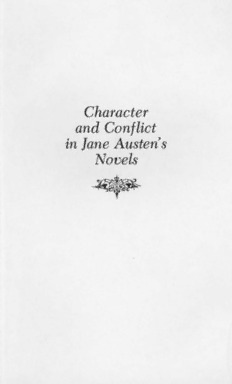
Character and Conflict in Jane Austen’s Novels A PSYCHOLOGICAL APPROACH PDF
Preview Character and Conflict in Jane Austen’s Novels A PSYCHOLOGICAL APPROACH
Character and Conflict in Jane Austen's Novels sf~ Character and Conflict in Jane Austen's Novels A PSYCHOLOGICAL APPROACH Bernard J. Paris Michigan State University Wayne State University Press Detroit, 1978 Copyright @ 1978 by Wayne State University Press, Detroit, Michigan 48202. All rights are reserved. No part of this book may be reproduced without formal permission. Library of Congress Cataloging in Publication Data Paris, Bernard J Charactera nd conflict in Jane Austen's novels. Includes biliographical references and index. 1. Austen, Jane, 1775-1817- Characters. 2. Charactersa nd characteristicsi n literature. 3. Psychology in liter- ature. I. Title. PR4038.C47P3 823'.7 78-13281 ISBN 0-8143-1616-6 For Susan Contents Preface 9 J Form, Theme, and Mimesis 13 2 Mansfield Park 22 3 Emma 64 4 Pride and Prejudice 96 5 Persuasion 140 6 Jane Austen: The Authorial Personality 168 Notes 202 Index 205 The novelist, we are beginning to see, has a very mixed lot of ingredients to handle. There is the story, with its time-sequence of 'and then . . . and then ... ' there are ninepins about whom he might tell the story, and tell a rattlingg ood one, but no, he prefers to tell his story about human beings; he takes over the life by values as well as the life in time. The characters arrive when evoked, but full of the spirit of mutiny. For they have these numerous parallels with people like ourselves, they try to live their own lives and are con- sequently often engaged in treason against the main scheme of the book. They 'run away,' they 'get out of hand': they are creations inside a creation, and often inharmonious towards it; if they are given complete freedom they kick the book to pieces, and if they are kept too sternly in check, they revenge themselves by dying, and destroy it by intestinal decay. E. M. Forster, Aspects of the Novel Preface The central thesis of this study is that Jane Austen's mature novels are not the models of organic unity which most critics hold them to be, but that they are beset by tensions between form, theme, and mimesis. As the first chapter will show, these tensions have several sources, the most important of which is the fact that Austen's protagonists are at once aesthetic, illustrative, and mimetic characters. They are "creations inside a creation" and, as such, are "often en- gaged in treason against the main scheme of the book." Since they have "numerous parallels with people like ourselves," they must be understood not only in formal and thematic, but also in motivational terms, in the same way that we understand real human beings. After my opening discussion of the sources of tension in Jane Austen's fiction, I shall offer formal, thematic, and psy- chological analyses of her four greatest novels. I shall use the theories of Northrop Frye to analyze the comic structures of Jane Austen's novels and those of Karen Homey and other Third Force psychologists to analyze her characters and her authorial personality. Frye makes only a few references to Jane Austen, but his discussion of the mythos of Spring fits her novels extremely well. The use of psychological theory will enable me to do justice to Jane Austen's mimetic achievement. 9 Preface It will result in a completely new understanding of her heroines, in a greater appreciation of her genius in characterization, and in a fresh interpretation of her authorial personality. I shall conduct my thematic analyses with the conventional tools of such criticism, though my findings, I think, will often be original. The reader will notice that I do not discuss the novels in the order of their composition. Although Elizabeth Bennet is Aus- ten's first great mimetic character, she is one of the most diffi- cult to understand from a psychological perspective. I have chosen to begin with Fanny Price, whose problems are more obvious. I discuss Emma next because it and Mansfield Park so beautifully complement each other. After the analyses of Fanny and Emma have been completed, it will be easier to understand the more elusive characterizations of Elizabeth and Anne. In the final chapter, 1 shall reconstruct the personality which can be inferred from all of Jane Austen's writings. I shall consider her works chronologically and attempt to explain the psychodynamic process which leads her from novel to novel. There are three competing versions of Jane Austen which have emerged from the criticism. Some critics emphasize the aggres- sive, satirical component of her art; some stress her gentleness and conservatism; and some focus upon the detached, ironic quality of her vision. I believe that each group of critics is overemphasizing something which is there. When I analyze Jane Austen's authorial personality, I shall try to show how these diverse components of her nature are related to each other in a structure of inner conflicts. Those who know Jane Austen criticism will be familiar with the proponents of each of the positions described above. I have chosen, for the most part, to summarize critical contro- versies rather than to document my agreements and disagree- ments with individual critics. This book has most in common with the psychological studies of Marvin Mudrick (Jane Aus- ten: Irony as Defense and Discovery) and D. W. Harding ("Regulated Hatred: An Aspect of the Work of Jane Austen," Scrutiny, VIII [1940], 346-62), but its approach and its findings differ considerably from theirs. I am indebted to these and other critics primarily for the stimulus of their ideas, rather 10
